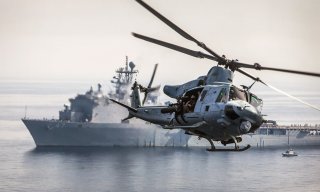Battle Taxis: The Marines’ Light Amphibious Warship Was Built to Fight China
The Marine Corps is returning to its maritime heritage
The Congressional Research Service (CRS), a non-partisan think tank that prepares reports for the United States Congress, recently released a report on the Marine Corps’ future aquatic battle taxi: the Light Amphibious Warship.
The Light Amphibious Warship program, also known as the LAW, “envisions procuring a class of up to 35 new amphibious ships to support the Marine Corps, particularly in implementing a new Marine Corps operational concept called Expeditionary Advanced Base Operations (EABO).”
EABO is a part of the Marine Corps commandant Gen. David H. Berger’s Force Design 2030, a doctrinal guide that will implement some of the most radical restructuring of the Marine Corps since World War II.
In contrast to the non-state actors that the Marine Corps fought in the Middle East as a part of the United States’ war on terrorism, defined by incredibly long, grinding land campaigns, the Corps is now laser-focused on one rival, and one rival only: China. And to better fight the Chinese military, the Marine Corps is going all in.
EABO will see small groups of highly trained Marines spread out in a very decentralized fashion over the Indo-Pacific region, also the world’s largest ocean and geographically the United States military’s largest combat command.
The Marine Corps is, in essence, returning to its maritime heritage. In a littoral environment, a premium is placed on vehicles and equipment that can swim. To better prepare for a high-end fight that could take place partially at sea, the Marine Corps had divested all of its tank battalions and a great deal of its tube mortar and artillery battalions as well.
But in order for Expeditionary Advanced Base Operations to succeed, the Marine Corps needs small, affordable ships for groups of Marines and their equipment around the Pacific: the Light Amphibious Warship.
The CRS document explains that “littoral maneuver will rely heavily on surface platforms such as the light amphibious warship (LAW) and a range of surface connectors, as well as aviation assets. The LAW is envisioned as the principal littoral maneuver vessel of the littoral force…”
“The LAW supports the day-to-day maneuver of stand-in forces operating in the LOA [littoral operations area]. It complements L-class amphibious ships and other surface connectors. Utilizing the LAW to transport forces of the surface reduces the impacts of tactical vehicles on the road network, increases deception, and allows for the sustainment of forces during embarkation.”
It adds that the “range, endurance, and austere access of LAWs enable the littoral force to deliver personnel, equipment, and sustainment across a widely distributed area. Shallow draft and beaching capability are keys to providing the volume and agility to maneuver the required capabilities to key maritime terrain. LAW employment requires reconnaissance and prior planning relating to the bathymetry of the littoral environment. Effective LAW employment relies on knowledge of the beach makeup, slope, currents, tidal effects, and other environment factors.”
So while the U.S. Marine Corps’ Light Amphibious Warships are not here yet, they soon will be—and they’ll be the Corps’ battle taxis.
Caleb Larson is a multimedia journalist and defense writer with the National Interest. A graduate of UCLA, he also holds a Master of Public Policy and lives in Berlin. He covers the intersection of conflict, security, and technology, focusing on American foreign policy, European security, and German society for both print and radio. Follow him on Twitter @calebmlarson.
Image: Flickr.

